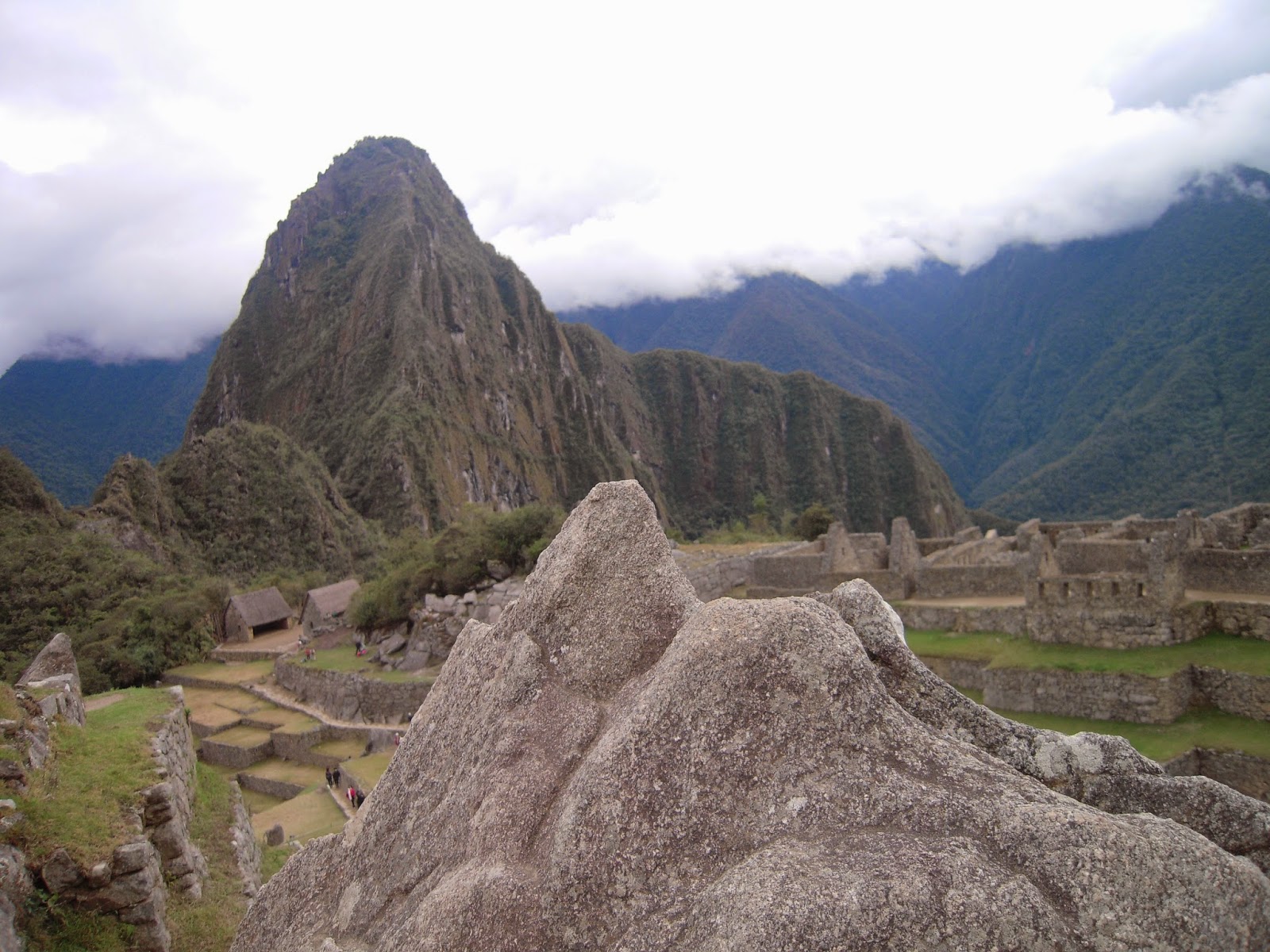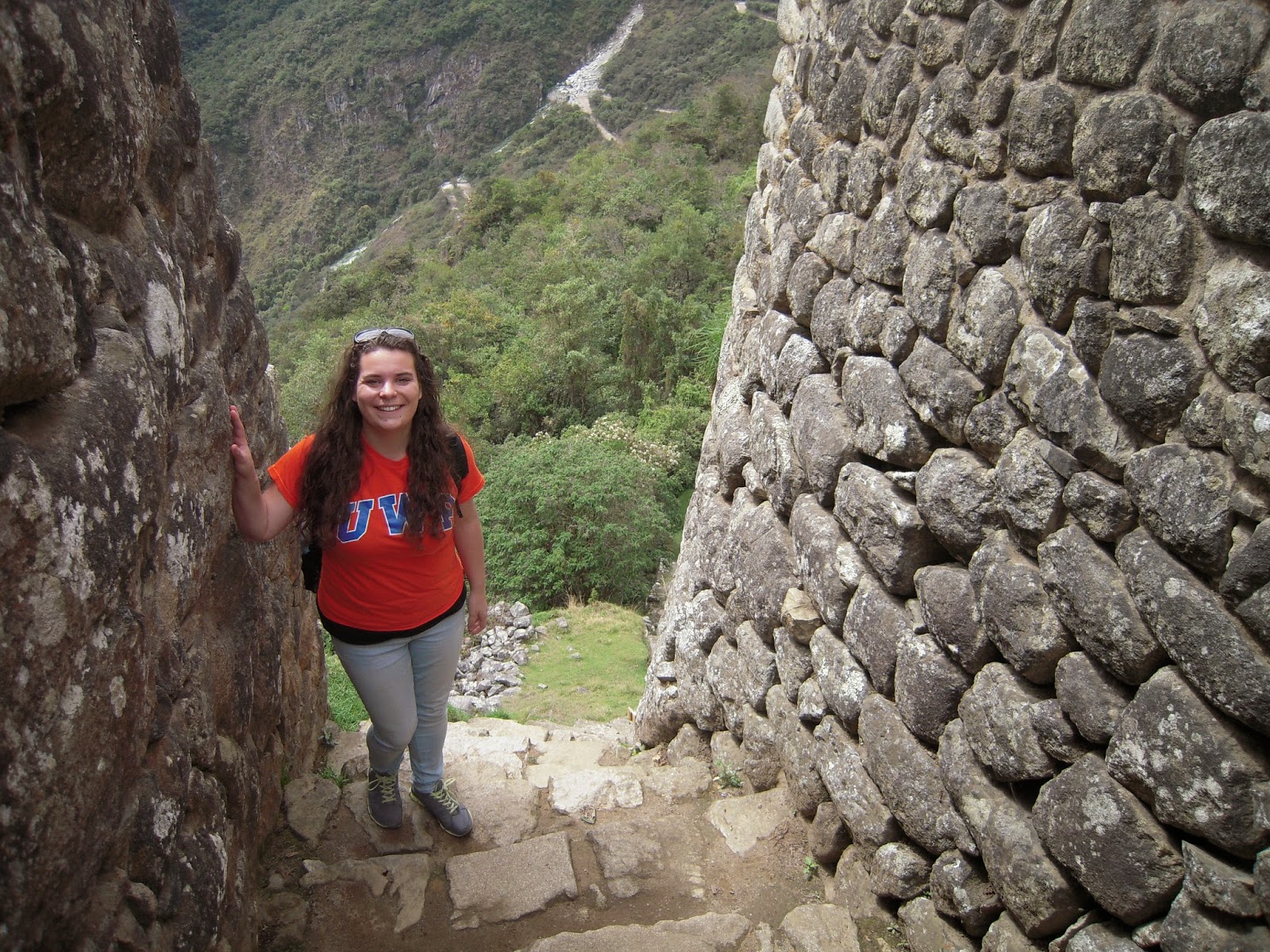Our second day in Cuzco was devoted to an all day tour of the Sacred Valley of the Incas, also known as the dozens of Inca sites that are spread across the valley from Cuzco to Machu Picchu. Our first stop was on the outskirts of the city to see the impressive remains of the popular site Saqsayhuaman. The ruins are made of giant stones cut perfectly to size -- like the majority of Inca ruins -- and featured many terraced layers. The Spanish originally thought that it was a fortress, but archaeological evidence now shows that it was most likely a temple of some sort, probably one devoted to Mother Earth.
 |
| The stone ruins of Saqsayhuaman. The top most stones display an excellent example of precise Inca stone masonry. |
After a disappointingly short time spent at the site (we needed to move on in order to see everything on the schedule AND catch a train later that day), we got back on the bus to continue into the valley. Our guide, Patrick, told us that during that section of the ride, we were ate the highest altitude of our Cuzco trip -- just under 3,600 meters. Even Machu Picchu was lower than that. Driving through the Andes was amazing because the slopes were so huge and everything was green, brown and very rugged. Every so often, we would see the clusters of tile collections that signified a small Andean settlement. On the way, we saw the round tower-like ruins of Pacapucara, which was more than likely an Inca stronghold or lookout post as its name means "red fortress" in Quechua. Patrick speaks fluent Quechua, and even treated us to a small lesson on the bus.
We drove through a valley that still had Inca-age terraces on the mountainside and current farm fields in the valley. Even though there were modern roads, cards, and telephone wires, you could alost feel that time and conquest had not passed and that the people living in the towns and fields were livling in much of the same way as the Incas had.
Our next stop was the little town of C'orao, a place known for its fine quality alpaca and llama products. Here we stopped at the living museum of Awana Kancha, a place dedicated to the preservation and practice of traditional textile weaving, coloring and making. They had live alpacas that we could pet, feet and take pictures with as well as an excellent display of traditional pigments used for dyeing.
 |
| Feeding the llamas at Awana Kancha. They broke their way out of their pens to come and play with us. |
 |
| A traditional textile expert at Awana Kancha. She showed us the natural ingredients used to make different colors as well as taught us how to tell the difference between natural and synthetic wool products. |
Women in traditional Andean clothing sat barefoot along the path, working traditional looms and demonstrating how the fabric was made. They had a fancy store of their finished products, all of which were very beautiful and very, very expensive.
After the pleasant stop in C'orao (none of us thought we would have had the chance to feed and pet llamas!) we continued with our Sacred Valley tour until we reached the Mirador Turay, the spot on the side of the road that offers the classic yet beautiful view of the Sacred Valley of the Incas. Running between the base of the peaks in the distance is the Vilcamayo -- which means sacred river -- later renamed Urubamba by the Spanish.
 |
| The "classic" view of the Sacred Valley of the Incas. |
 |
| The entire CIEE group in the Sacred Valley from left to right: Alicia, our professor Sonia, Garrick, Jesse, Natalie, Hank, Ariana, her friend Stefanie, Me, Andrea, and our program adviser Marion. |
Our next stop on our tour was the town of Pisaq -- also spelled Pisac -- which is a settlement at the base of a
huge terraced, green-faced Andean peak. Pisaq also had Inca ruins, a old settlement with a breathtaking view of the surrounding slopes and fields. Here we were able to see the traditional leveled terraces used by the Incas for high altitude agriculture. These terraces -- which are now protected -- are slowly being destroyed, ironically because they are not being used. We climbed all the way to the top of the settlement, a demanding climb in and of itself, let alone combined with extremely high altitude, but the view was worth it.
 |
| The terraced agriculture fields used by the Incas at Pisaq. |
 |
| A view of the scenery from the top of the Pisaq settlement. |
Our final stop of the tour was in Ollantaytambo, a beautiful city with some of the best Inca ruins outside of Machu Picchu. I fell in love with it from the moment we arrived. It's located in the middle of three majestic peaks in the same spot where three valleys converge, making it a wind tunnel in the extreme. Ollanta was the star of the Inca version of Romeo and Juliet, and Tambo was where he made his last stand against Emperor Pachacutec. Thus, the place is now named after him. The town is in the valley and the Inca ruin attractions are on the mountainsides all around it.
One one of the mountainsides sits the ruins of Ollantaytambo itself, an unfinished Inca project from right before the Spanish conquest. Experts believe it was meant to be a sun temple because the rays from the sun during the summer solstice rises behind the eastern peak and would fall directly on the ruins. In ancient times, the ruins would have held plates of sliver and gold, setting the entire valley alight with shimmering light. Unfortunately, the project was never completed due to the outbreak of civil war between Atahualpa and his brother Huascar. After this conflict, the Spanish arrived, and so Ollantaytambo now sits unfinished, a masterpiece of unrealized potential.
 |
| A view from the ruins overlooking the modern town and the giant peaks of the surrounding mountains. |
 |
| A famous wall near the top of the ruins. The rounded bump in the middle of the bottom panel used to be a carved jaguar head, one of the sacred animals of the Incas, but it's believed that when the Spanish arrived, they smashed off the carved heads in an effort to destroy the traces of indigenous culture and religion. |
On the upside, the unfinished site does give us a little insight into how the Incas managed to build their wonderful structures. Large unincorporated stones sat near the top, and Patrick explained a theory in which the Incas used knowledge of local plants to make a kind of acid to make their super straight cuts in the massive stones. We climbed all the way to the top of Ollantaytambo and were able to look down on the entire valley.
Off to the west, through a gap in the peaks, we were able to see distant peaks that were capped in snow. The three mountains that surrounded the Ollantaytambo Valley had peaks so high, the clouds swirled around the tips. Across the valley on the opposite peak, we saw a columned yellow stone fortress built into the mountainside. To its left, was a face-like natural rock formation that apparently resembles one of the Inca gods.
 |
| The incomplete temple of Ollantaytambo cut into the mountainside. |
After we were finished taking in the breathtaking sights, we descended back into the town to kill some time before our train left. A few of the other students and I bought beef kebabs from a street vendor which were delicious. I followed a stone path that ran on top of an ancient terrace in the modern town. On one side was one of the famous gurgling canals that are present all through the town along with the well-kept gardens of beautiful flowers. On the right side of the lower terrace, I could see the backyards of some of the local residents. The houses were rather run down and their animals roamed free, but brightly-colored laundry snapped from the clothes lines, and the people and their children laughed and talked. It was neat to get away from the tourist places and see something more akin to real life.
After a lovely day, we regrouped at the train station to depart. The train had glass ceiling windows, but because it was night, we couldn't see much. Instead, we played a rousing game of Uno, and finally arrived in our hotel in Aguas Calientes, the mismatched tourist down at the base of the mountain, and the starting point for our final stop in our journey -- the ruins of Machu Picchu.




















